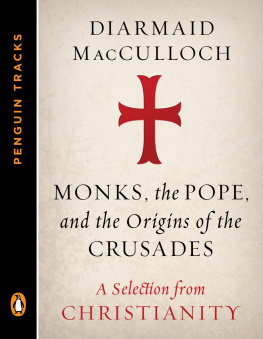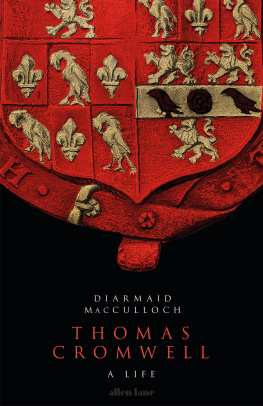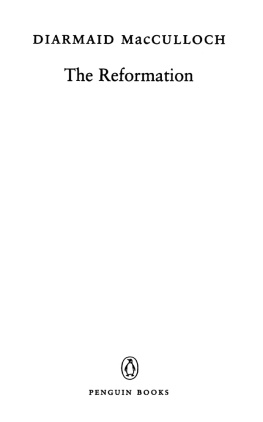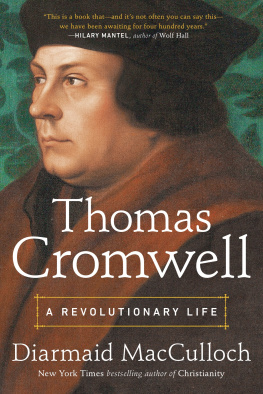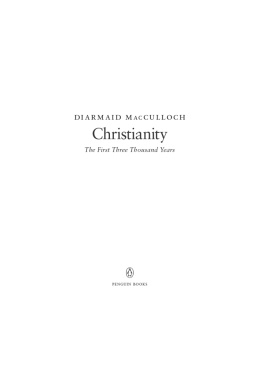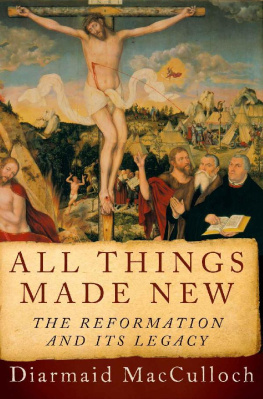CONTENTS
MONKS, THE POPE, AND THE ORIGINS OF THE CRUSADES
PENGUIN TRACKS
MONKS, THE POPE, AND THE ORIGINS OF THE CRUSADES
DIARMAIDM AC CULLOCH is Professor of the History of the Church at Oxford University. He is the New York Times bestselling author of Silence: A Christian History; Christianity: The First Three Thousand Years, winner of the Cundill Prize and the Hessell-Tiltman Prize; The Reformation: A History, winner of the National Book Critics Circle Award, the Wolfson Prize, and the British Academy Prize; and Thomas Cranmer: A Life, winner of the Whitbread Prize, the James Tait Black Prize, and the Duff Cooper Prize. A Fellow of the British Academy and the Royal Historical Society, MacCulloch was knighted in 2012 for his services to scholarship. He lives in Oxford, England.

ALSO BY
DIARMAID M AC CULLOCH
THOMAS CRANMER: A Life
THE REFORMATION: A History
CHRISTIANITY: The First Three Thousand Years
SILENCE: A Christian History
ABOUT THE BOOK
A product of electrifying scholarship conveyed with commanding skill, Diarmaid MacCullochs Christianity: The First Three Thousand Years stretches from the Greek Platonists and the origins of the Hebrew Bible to the present and encompasses the globe. In this excerpt, MacCulloch chronicles the rise of monasteries like the great Cluny Abbey, which formed orders that reached across secular kingdoms, enjoying exclusive papal privileges and encouraging their followers to make pilgrimages among towering cathedrals and far-flung shrines. Meanwhile, the introduction of the tithe, expanding control over marriage, and a new emphasis on Purgatory brought penitent parishioners even closer to the Church and dependent on ministry. By the time Pope Urban II launched the First Crusade, the practice of indulgences had made possible his grant that all who died in a state of repentance and confession while fighting would gain immediate entry into heaven. Holy War spawned whole new orders, most famously the Knights Templar and the Knights Hospitaller, as soldiers from across Europe joined the campaigns of conquest toward Jerusalem. The many causes and consequences of these clashes between Christianity and Islam are captured here in illuminating detail with elegance and wit.
Diarmaid MacCullochs latest book, Silence: A Christian History, is available from Viking.
PENGUIN BOOKS
Published by the Penguin Group
Penguin Group (USA) LLC
375 Hudson Street
New York, New York 10014

USA | Canada | UK | Ireland | Australia | New Zealand | India | South Africa | China
penguin.com
A Penguin Random House Company
Copyright 2009, 2013 by Diarmaid MacCulloch
Penguin supports copyright. Copyright fuels creativity, encourages diverse voices, promotes free speech, and creates a vibrant culture. Thank you for buying an authorized edition of this book and for complying with copyright laws by not reproducing, scanning, or distributing any part of it in any form without permission. You are supporting writers and allowing Penguin to continue to publish books for every reader.
The contents of this book first appeared in Diarmaid MacCullochs Christianity: The First Three Thousand Years (Viking Penguin, 2010; Penguin Books, 2011).
eBook ISBN 978-1-101-63087-7
Abbots and Warriors in the Age of Cluny
For a French provincial town with just over four thousand inhabitants, Cluny in Burgundy boasts more than its fair share of ne stone medieval houses, towers from a generous circuit of former town walls, and three church spires in its skyline. Yet the place is haunted by an absence. The nature of that absence becomes clear if one seeks out the most imposing of those church spires in the town centre, only to nd it topping a very peculiar building, a monumental empty Romanesque domed hall bafingly tall in proportion to its oor area. To enter this medieval elevator shaft of space is to realize that it was part of something much bigger. It is in fact one single transept from what was between the eleventh and the sixteenth centuries the largest church building in the world. The churchs ancient splendour made it a symbol of all that the French Revolution hated. After a mob sacked it in 1790, the shell was sold to a building contractor, who took three decades to pull it down, all except this sad, towering remnant. The Emperor Napoleon had a stud farm built over much of the empty site. Until those dismal years, the prodigious church proclaimed the importance of the abbey which had created it.
At the beginning, Cluny Abbey had not been unique. Its foundation in 90910 coincided with a new phase in the constant urge to renewal in Western monastic life, as bishops and aristocrats thought that the best way to battle against monastic complacency and corruption was to devote huge resources in land and wealth to the creation of ever more splendid Benedictine houses. In the same era England witnessed a burst of parallel activity, vigorously supported by an expanding monarchy. The English were now precociously united under a single king. From the time of the pious and energetic King Alfred (reigned 87199), the kings of Wessex had done their best to ght off invasion and occupation by Danish and Viking armies to create a version of Carolingian monarchy, just at the time when the Carolingians themselves were descending into quarrels and failure. Alfreds successors Aethelstan and Edgar achieved the united English kingdom anticipated in the Church of Augustines mission and in the writings of Bede. The uniting of England provoked an outburst of pride that had a distinctive and galvanizing effect on the English Church.
Clunys founder, Duke Guillaume of Aquitaine, had endowed the abbey lavishly but made unusually few demands in return, in reward for which generosity monastic posterity gratefully entitled him the Pious. A century later, a series of exceptionally shrewd and capable abbots built on this freedom of manoeuvre; they took their cue both from a provision in Duke Guillaumes founding charter placing them under the popes special protection and from the example of Fleury, that much older Frankish monastery which, with exceptional and ruthless enterprise, had pioneered a special relationship with Rome. In 1024 Odilo, Abbot of Cluny from 994 to 1049, followed Fleurys example in gaining exclusive papal privileges; he also began major rebuilding and enlargement campaigns at the abbey.
One should never underestimate the signicance of architecture in Christianity and particularly not in the era of reform which now emerged. There was a vast amount of church-building, precisely because to rebuild a church building was regarded as a sacramental sign of institutional and devotional renewal in the Church: each new church was a reform in stone. One chronicler from Cluny saw the Christian world as clothing itself with a white mantle of churches, having safely passed the watershed of 1000, when the end of the world might have been expected (Cluny made rather a fuss about this millennium, while it is not at all clear that others did). Worship in the church of Cluny itself was renewed in spectacular style amid the builders scaffolding. Its monk-clergy celebrated an unbroken round of Masses and ofces, while the centrepiece of these subsidiary dramatic performances were High Masses unequalled elsewhere in their splendour and solemnity. Western Europeans marvelled at this offering to God, and when they hastened to imitate it by endowing their own versions of Cluny, the abbots of Cluny harnessed this enthusiasm in a new way. Rather than simply giving their blessing to new independent abbeys in the traditional Benedictine manner, they demanded that each foundation should form part of a new international organization run by the abbot of Cluny himself, as priories to his abbey: they would form a Cluniac Order the rst monastic organization to bear this title in which the abbot would progress round the priories and priors would gather at the mother house on a regular basis.

